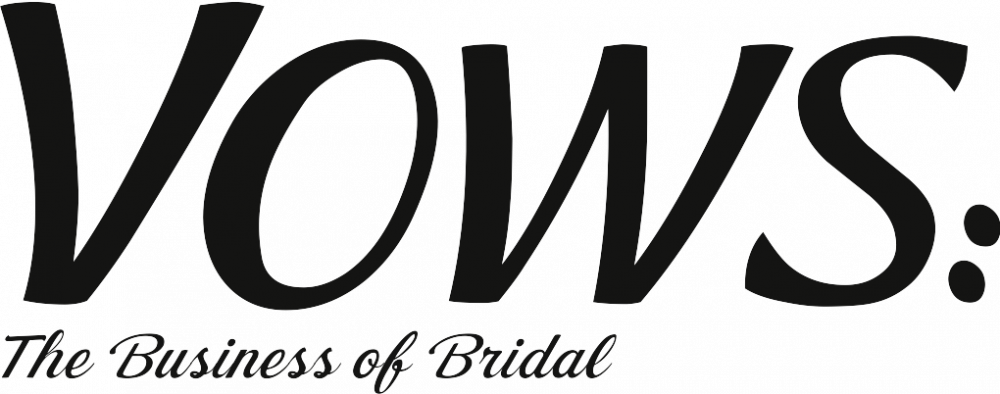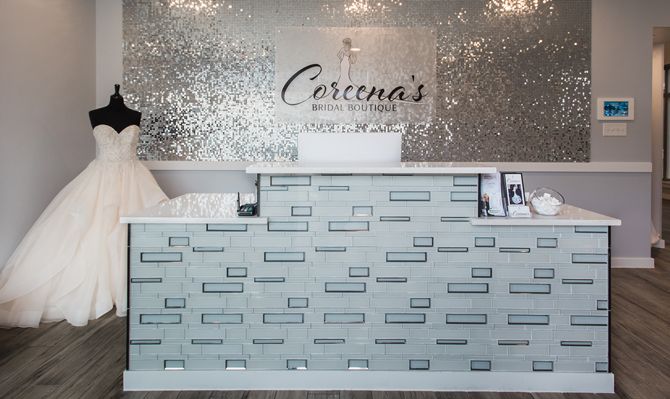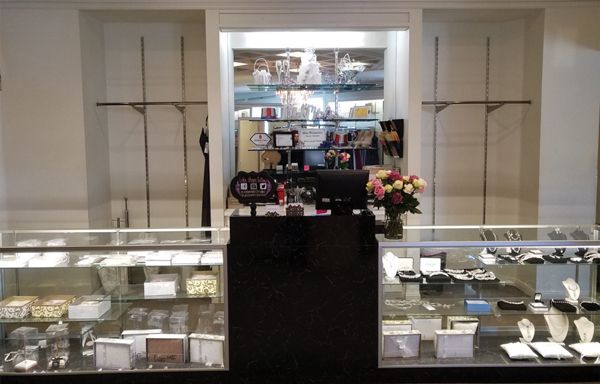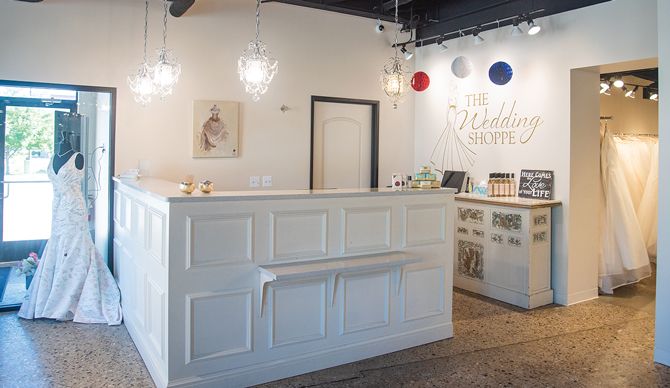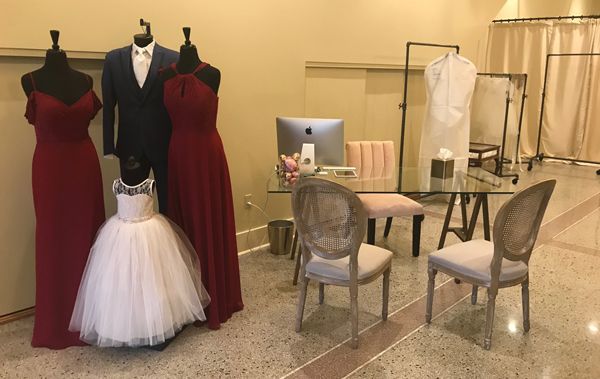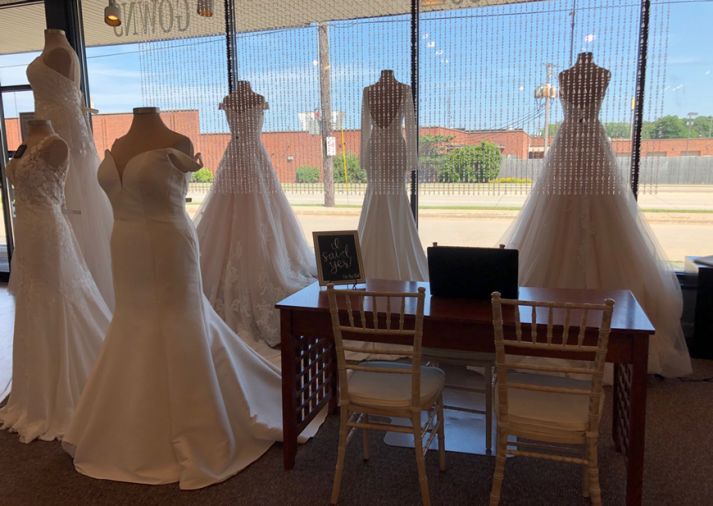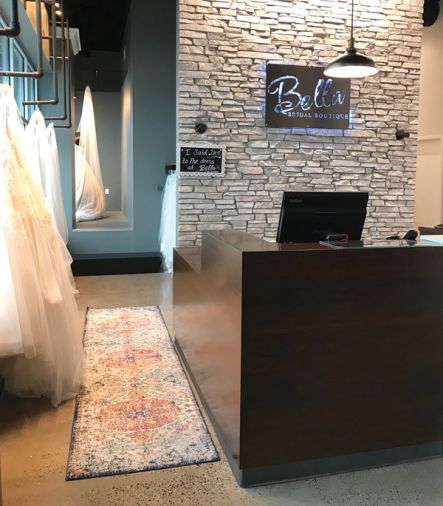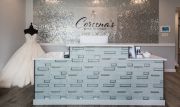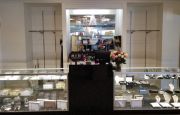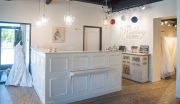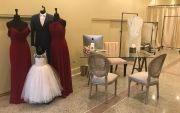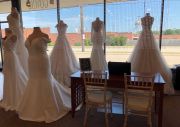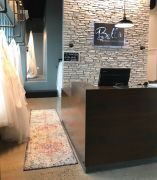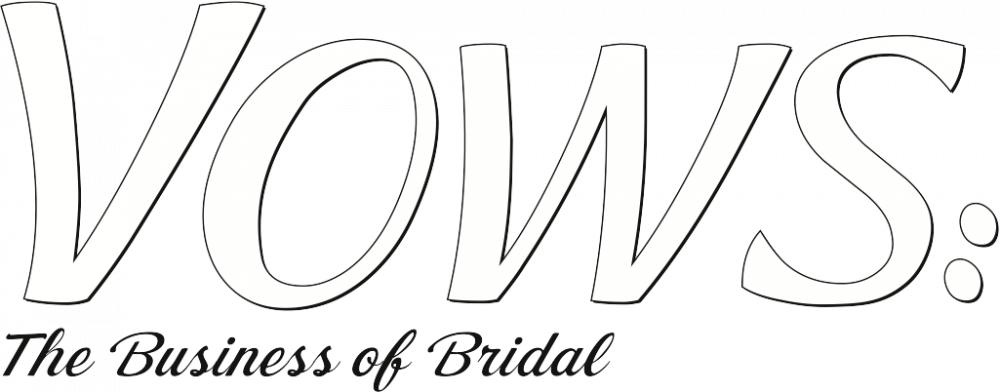When customers check out at Coreena’s Bridal Boutique in College Station, Texas, they are greeted by a wall of shimmering silver sequins, which closes out the bridal shopping experience with pizzazz.
After much time spent browsing, trying on and discussing, brides and their mothers often feel exhausted, elated and possibly even a bit nervous when they make it to the checkout counter. As it’s the final stop of their bridal gown buying experience, it’s vital to create the right impression and say goodbye to them on a high.
These counters often serve a dual purpose of check out and check-in; for both, a positive experience is a must. But for check out purposes in particular, sending brides away feeling great about your store is crucial, as it enhances the likelihood they’ll tell everyone about their experience.
Little touches, big impression
At Coreena’s Bridal, the sequined wall is behind the checkout/welcome counter, so it’s both a goodbye gesture and a welcome.
“It’s a huge attention-grabber because we keep a fan running under the front counter that keeps the sequins moving at all times,” says owner Coreena Ferrata.
She imported the sequins already attached to tiles from England, and opted for silver because it’s neutral and modern and fits with her color scheme. The store’s logo is featured over the sequins. The wall has become a big photo op area in the 10 months since the store opened.
Having the wall there also creates a clear separation between the check out/welcome area and the rest of the store, Ferrata explains.
The desk itself is white, centered under the sequin wall and kept deliberately uncluttered. It contains a few business cards for local vendors and mints featuring the store’s logo. Between the desk and wall there’s always a mannequin wearing a bridal gown.
“Having the mannequin up front adds a more upscale feel,” Ferrata says. Finally, she keeps the desk somewhat separate from the store, to keep the bride apart from her entourage.
“Some of our brides don’t want others knowing how much their gown costs,” she says.
Relationship building
The situation is almost reversed at Deborah’s Bridal in Upland, Calif. Here the checkout counter is at the back of the store, for both security and to allow employees to be face-to-face with customers. During her retail training, owner Deborah Armbruster learned that checkout counters were usually placed in the back of stores for several reasons, two still prevalent today:
“First you want to make sure your cash drawers are always secure and the best place for that is not in the front of the store, near the exit,” she says. “Second, and most important, is the ability to serve your customers in hopefully a quieter atmosphere with a personal touch. And also it gives the store the ability to do a better display of add-on merchandise along with a wall-hang bar that is needed to display the products you’re selling.”
Armbruster wants her checkout counter to be “candy for the eyes.” It’s made up of two glass display cases with fluorescent lighting, with a marble-looking section at each end and in the middle. Each case holds a computer to take orders and payment and displays additional items like jewelry and garters.
“Those are all little things that come up at the point of the sale,” she says. “People tell us they don’t want to go to another store to pick something up. We sell so many of those things it’s crazy. Brides are also on a high at this point, so are ready to buy something else.”
It’s also smart to display add-on merchandise near the checkout because this is typically the time where other people buy things for the bride, such as sisters, maid of honors, aunts, she says.
The glass counters also contain glass shelves, “which feels clean, organized, bright and pretty,” Armbruster says. This helps allow every item to be seen.
Behind the counter is another mirror that reaches the ceiling, with glass shelves containing fun items like a sparkly pair of shoes and champagne glasses.
“It gives them something to look at and adds to the feeling they have when they leave,” Armbruster says.
In fact, the counter’s so enticing that most customers look at it before anything else, she says. Armbruster frequently has a vase of flowers displayed too.
“Fresh flowers are a wonderful touch and we try to have them as often as possible,” she says. “The flowers bring about a happiness from our customers while we are ringing.”
The checkout counter also serves another purpose: It’s waist-high and about 24 inches wide, “so you’re right next to your customers, and that’s the most important thing for a business owner,” Armbruster says. “It’s the conclusion of why you’ve put all that effort in – for that sales transaction. It has to be perfect and correct to show you are a business professional.”
Finally this entire area is very well-lit.
“For bridal you have to have the right type of lighting,” she says. “It makes everything sparkle.”
Impulse buy opportunity
At Tie the Knot Bridal Boutique in Green Bay, Wisc., there are two checkout counters; both are at the front of the store placed between the window display and showroom.
The main checkout counter has two chairs, since brides’ mothers are usually with them, and it allows them to sit in a relaxed manner and go through the order. There’s a secondary checkout counter (where employees also greet customers), that’s high, and six to seven feet long, which customers stand at. This one’s typically used for bridesmaids, unless the other desk is available, and is also used to merchandise some add-ons like garters and fabric tape.
“Typically there’s an impulse buy at this counter by a mom, grandma, aunt, or someone else,” says owner Brenda Kilheffer.
There’s also the ‘I Said Yes!’ sign there and customers often take photos at that desk with the window display featuring mannequins behind them.
Behind the checkout counters is a wall of beads to separate them from the rest of the store, then the next thing brides see is more mannequins wearing gowns. The beads create a division for the window display “and they add sparkle both inside and outside,” Kilheffer explains. “So sunlight and track lighting pick up the bead sparkle.”
This area, she says, is lighter and brighter than further back in the store, so the gowns displayed here look “bright and sparkly.”
Kilheffer has, in the past, experimented with checking customers out using iPads in the fitting rooms but found consultants had to go up front to run credit cards, and it also held up the fitting room for too long, especially on a busy Saturday when they needed to prepare for the next appointment.
Creating connections
Lisa Downs and her daughter, Ciara Ellen Short, who works for her, disagreed when creating the checkout counter at Ellen’s Bridal & Dress Boutique in Wabash, Ind.
Short wanted a built-in counter, where both the customer(s) and the consultant would be seated.
“She feels that would be more permanent-looking and professional,” Downs says. “I feel that does not lend itself to conversation and relationship-building.”
Instead, Downs opted for a glass desk with chairs “because it lends itself to the feeling of a personal meeting with all participants on an even level,” she says. “We are having a conversation about the transaction as well as our processes and helpful services going forward. This way, it doesn’t feel like it’s all about taking their money. It feels like we’re continuing to build a relationship.”
The desk is about a third of the way into the store, after the greeting area and before the dressing rooms and merchandise. This allows the consultant sitting there to see the door and welcome people if everyone else is busy. There are mannequins by it, too, featuring mostly bridesmaid dresses and tuxedos, “which hopefully tells them we do those other services without it being in their face,” Downs explains. “We have to be strategic in getting some of these things in front of them.”
As for the desk itself, glass gives a clean look, the computer is pushed to one side, and there’s very little else on it. Downs doesn’t allow local businesses to display their cards there “because it makes it too cluttered and makes it more salesy,” she says.
The area itself is brightly lit by chandeliers and canned lighting (recessed) so brides and their mothers can easily read the itemized receipts.
The check out process, says Downs, is as important as any other part of the bridal experience, and it’s vital that brides and their mothers leave happy.
“That’s what they’re going to carry with them and it caps off the experience and they then share it by word of mouth,” she says. “It’s an enjoyable time to sit there and have conversations and talk about other parts of the wedding. It’s really about relationship-building.”
Keeping things separate
Kirsten Walfoort just moved Bella Bridal Boutique into a new location in Lake Elmo, Minn., in May. Here, she’s created a U-shaped front desk. The front and one side of the desk are in the front lobby and the other side is up against the showroom.
“This helps us better direct appointments as we can ring up sales in a different area and help with congestion at the front desk,” Walfoort says.
In the old store customers got backed up “and we’d be trying to check people in and ring others up, all at the same time. Now they are kept separately,” she says.
She can also just flip around the computer for customers to show them orders, receipts, websites or designs.
Behind the counter, there’s a high stone wall that features the store’s name on a backlit metal sign. This is permanently lit so it can be seen from the sidewalk, too.
“It’s a statement piece,” Walfoort says.
The wall also features two horizontal metal posts where dresses can hang when brides are checking out or picking up their gowns.
A priority for this counter was making it clean, organized and uncluttered, Walfoort says. All transactions are completed on tablets, and the desk features nothing but stylists’ business cards, and no accessories, due to theft.
“It looks messy if you have too much on there,” she says, “and it can be really stressful. It’s also nicer for the employees.”
Under the desk there are drawers and shelves and a built-in cash register. Everything has a place to go, she adds.
The counter is made from wood and the overlay is quartz, though looks like marble.
Michelle McFarland also custom-made her counter at The Wedding Shoppe in Berkley, Mich., which serves as the check-in and checkout desk. It helps when checking brides in, she says, for them to see elated brides check out.
“I definitely believe in the buy-in frenzy,” McFarland says. Like Downs, she has pendant chandeliers over the checkout desk, to add a touch of glamour, and the countertop is sparkly too, since it has glitter in it.
“We want brides to feel they’re in the most glamorous place in the world,” she says. “The ambiance in the store is very important and setting the right mood for the bride is essential, because it’s a very special day for her.
